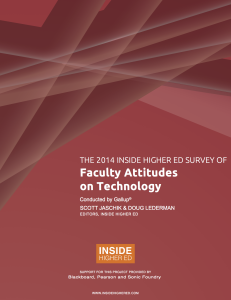Inside Higher Ed’s third annual survey of college and university faculty members and campus leaders in educational technology aims to understand how these groups perceive and practice online learning and other emerging opportunities for delivering course content.

Some of the questions addressed in the study are:
- Can online courses achieve learning outcomes that are equivalent to in- person courses?
- What are the most important quality indicators of an online education?
- How does the quality of online courses compare with the quality of in- person courses?
- To what extent have faculty members and technology administrators experienced online learning themselves, as students?
- To what extent have faculty taught online, hybrid, and face-to-face courses? For those who have not taught online, why is that?
- How supportive are institutions of online learning?
- Which should cost the student more — online degree programs or those delivered face to face?
- Who should be responsible for creating and marketing online degree programs?
- Are institutions expanding online learning? Should they do so? To what extent do faculty feel that they are appropriately consulted in this decision- making process?
- How do faculty use learning management systems (LMS) and early warning systems?
Snapshot of Findings
- Few faculty members (9 percent) strongly agree that online courses can achieve student learning outcomes that are at least equivalent to those of in- person courses. Academic technology administrators are more likely (36 percent) to strongly agree with this statement.
- Asked to rate the importance of factors reflecting quality in online education, faculty members and academic technology administrators alike say it is “very important” that an online course or program “provides meaningful interaction between students and instructors” (80 percent for faculty, 89 percent for administrators), “is offered by an accredited institution” (76 vs. 84 percent), “has been independently certified for quality” (66 vs. 52 percent), and “leads to academic credit” (50 vs. 68 percent).
- While a larger proportion of technology officers than faculty members say online courses are of better quality than in-person courses in a set of eight areas, in neither group did any of the eight areas garner a majority reporting this view. But faculty members thought online courses could be at least as good as in-person
during class and 77 percent of faculty say the same about the ability to reach “at-risk” students. - Very few faculty members (7 percent) believe the tuition for online courses should be higher than for face-to-face degree programs. A much smaller proportion of faculty who have taught online courses believe online courses should have a lower tuition than face- to-face programs (20 percent), while nearly half of their peers who have never taught an online course (48 percent) believe that this should be the case.
- More technology administrators (53 percent) than faculty members (32 percent) have taken an online course for credit. Nearly half of those who have taught an online course (49 percent) have also taken an online course as a student, compared to less than a quarter (23 percent) of those who have never taught an online course.
- About one in three professors say they have taught an online course, with some variation across position type. Among those who have never taught an online course, the three main reasons they give are never having been asked, not being interested, and not believing that online classes have educational value.
- More than 8 in 10 instructors say they have converted a face-to-face course to a hybrid course. The majority report that this conversion decreased face-to-face time.
- Half (51 percent) of faculty believe improving the educational experience for students by introducing more active learning in the course is a very important reason for converting face-to-face courses to blended or hybrid courses.
- Nearly three-quarters of faculty believe that professors own the online course content and material they create.
- Less than half of faculty and technology administrators strongly agree that their institution offer instructors strong support for online learning, as measured by eight indicators.
- Nearly all professors (96 percent) agree that institutions should produce their own online degree programs and be responsible for marketing them (85 percent).
- About one-third of faculty strongly agree that their institution is planning to expand online course offerings, though only about one-sixth strongly agree that their institution should do so. A larger proportion of those who have taught an online course than their peers who have never done so strongly agree to the above two statements. Most faculty do not feel that they have been appropriately involved with decision making surrounding the expansion of online course offerings.
- A small fraction of faculty believe that spending on IT infrastructure (8 percent) and digital initiatives (7 percent) is too high. Faculty are split on whether spending in these areas are too low or just about right.
- The majority of faculty always use learning management systems (LMS) to share syllabus information with students (78 percent), record grades (58 percent), and communicate with students (52 percent). Only 20 percent of faculty members always use the LMS for lecture capture.
- Only 15 percent of faculty strongly agree that digital humanities has improved their teaching, 14 percent strongly agree that it has improved their institution, and 23 percent strongly agree that digital humanities has improved their research.
- The vast majority of faculty (89 percent) say their institution uses an early warning system, and 81 percent believe that those warning systems help students make significant learning gains.
The full report can be downloaded here.


Speak Your Mind